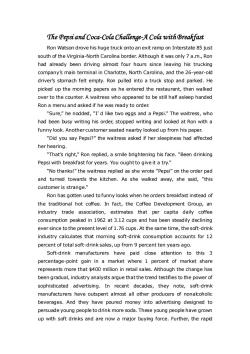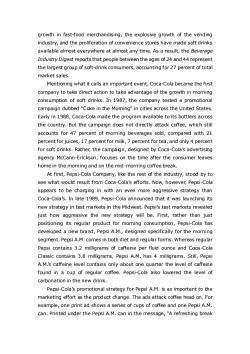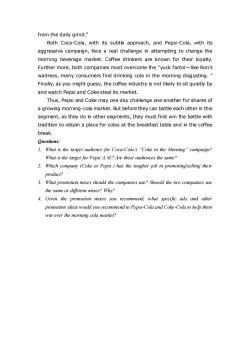《市场营销学》课程教学案例(双语)The Pepsi and Coca-Cola Challenge-A Cola with Breakfast

The Pepsi and Coca-Cola Challenge-A Cola with Breakfast Ron Watson drove his huge truck onto an exit ramp on Interstate 85 just south of the Virginia-North Carolina border.Although it was only 7 a.m.,Ron had already been driving almost four hours since leaving his trucking company's main terminal in Charlotte,North Carolina,and the 26-year-old driver's stomach felt empty.Ron pulled into a truck stop and parked.He picked up the morning papers as he entered the restaurant,then walked over to the counter.A waitress who appeared to be still half asleep handed Ron a menu and asked if he was ready to order. "Sure,"he nodded,"I'd like two eggs and a Pepsi."The waitress,who had been busy writing his order,stopped writing and looked at Ron with a funny look.Another customer seated nearby looked up from his paper. "Did you say Pepsi?"the waitress asked if her sleepiness had affected her hearing. "That's right,"Ron replied,a smile brightening his face."Been drinking Pepsi with breakfast for years.You ought to give it a try." "No thanks!"the waitress replied as she wrote "Pepsi"on the order pad and turned towards the kitchen.As she walked away,she said,"this customer is strange." Ron has gotten used to funny looks when he orders breakfast instead of the traditional hot coffee.In fact,the Coffee Development Group,an industry trade association,estimates that per capita daily coffee consumption peaked in 1962 at 3.12 cups and has been steadily declining ever since to the present level of 1.76 cups.At the same time,the soft-drink industry calculates that morning soft-drink consumption accounts for 12 percent of total soft-drink sales,up from 9 percent ten years ago. Soft-drink manufacturers have paid close attention to this 3 percentage-point gain in a market where 1 percent of market share represents more that $400 million in retail sales.Although the change has been gradual,industry analysts argue that the trend testifies to the power of sophisticated advertising.In recent decades,they note,soft-drink manufacturers have outspent almost all other producers of nonalcoholic beverages.And they have poured money into advertising designed to persuade young people to drink more soda.These young people have grown up with soft drinks and are now a major buying force.Further,the rapid
The Pepsi and Coca-Cola Challenge-A Cola with Breakfast Ron Watson drove his huge truck onto an exit ramp on Interstate 85 just south of the Virginia-North Carolina border. Although it was only 7 a.m., Ron had already been driving almost four hours since leaving his trucking company’s main terminal in Charlotte, North Carolina, and the 26-year-old driver’s stomach felt empty. Ron pulled into a truck stop and parked. He picked up the morning papers as he entered the restaurant, then walked over to the counter. A waitress who appeared to be still half asleep handed Ron a menu and asked if he was ready to order. “Sure,” he nodded, “I’ d like two eggs and a Pepsi.” The waitress, who had been busy writing his order, stopped writing and looked at Ron with a funny look. Another customer seated nearby looked up from his paper. “Did you say Pepsi?” the waitress asked if her sleepiness had affected her hearing. “That’s right,” Ron replied, a smile brightening his face. “Been drinking Pepsi with breakfast for years. You ought to give it a try.” “No thanks!” the waitress replied as she wrote “Pepsi” on the order pad and turned towards the kitchen. As she walked away, she said, “this customer is strange.” Ron has gotten used to funny looks when he orders breakfast instead of the traditional hot coffee. In fact, the Coffee Development Group, an industry trade association, estimates that per capita daily coffee consumption peaked in 1962 at 3.12 cups and has been steadily declining ever since to the present level of 1.76 cups. At the same time, the soft-drink industry calculates that morning soft-drink consumption accounts for 12 percent of total soft-drink sales, up from 9 percent ten years ago. Soft-drink manufacturers have paid close attention to this 3 percentage-point gain in a market where 1 percent of market share represents more that $400 million in retail sales. Although the change has been gradual, industry analysts argue that the trend testifies to the power of sophisticated advertising. In recent decades, they note, soft-drink manufacturers have outspent almost all other producers of nonalcoholic beverages. And they have poured money into advertising designed to persuade young people to drink more soda. These young people have grown up with soft drinks and are now a major buying force. Further, the rapid

growth in fast-food merchandising,the explosive growth of the vending industry,and the proliferation of convenience stores have made soft drinks available almost everywhere at almost any time.As a result,the Beverage Industry Digest reports that people between the ages of 24 and 44 represent the largest group of soft-drink consumers,accounting for 27 percent of total market sales Mentioning what it calls an important event,Coca-Cola became the first company to take direct action to take advantage of the growth in morning consumption of soft drinks.In 1987,the company tested a promotional campaign dubbed "Coke in the Moming"in cities across the United States. Early in 1988,Coca-Cola made the program available to its bottlers across the country.But the campaign does not directly attack coffee,which stil accounts for 47 percent of morning beverages sold,compared with 21 percent for juices,17 percent for milk,7 percent for tea,and only 4 percent for soft drinks.Rather,the campaign,designed by Coca-Cola's advertising agency McCann-Erickson,focuses on the time after the consumer leaves home in the morning and on the mid-morning coffee break. At first,Pepsi-Cola Company,like the rest of the industry,stood by to see what would result from Coca-Cola's efforts.Now,however,Pepsi-Cola appears to be charging in with an even more aggressive strategy than Coca-Cola's.In late 1989,Pepsi-Cola announced that it was launching its new strategy in test markets in the Midwest.Pepsi's test markets revealed just how aggressive the new strategy will be.First,rather than just positioning its regular product for morning consumption,Pepsi-Cola has developed a new brand,Pepsi A.M.,designed specifically for the morning segment.Pepsi A.M.comes in both diet and regular forms.Whereas regular Pepsi contains 3.2 milligrams of caffeine per fluid ounce and Coca-Cola Classic contains 3.8 milligrams,Pepsi A.M.has 4 milligrams.Still,Pepsi A.M.'s caffeine level contains only about one quarter the level of caffeine found in a cup of regular coffee.Pepsi-Cola also lowered the level of carbonation in the new drink. Pepsi-Cola's promotional strategy for Pepsi A.M.is as important to the marketing effort as the product change.The ads attack coffee head on.For example,one print ad shows a series of cups of coffee and one Pepsi A.M. can.Printed under the Pepsi A.M.can in the message,"A refreshing break
growth in fast-food merchandising, the explosive growth of the vending industry, and the proliferation of convenience stores have made soft drinks available almost everywhere at almost any time. As a result, the Beverage Industry Digest reports that people between the ages of 24 and 44 represent the largest group of soft-drink consumers, accounting for 27 percent of total market sales. Mentioning what it calls an important event, Coca-Cola became the first company to take direct action to take advantage of the growth in morning consumption of soft drinks. In 1987, the company tested a promotional campaign dubbed “Coke in the Morning” in cities across the United States. Early in 1988, Coca-Cola made the program available to its bottlers across the country. But the campaign does not directly attack coffee, which still accounts for 47 percent of morning beverages sold, compared with 21 percent for juices, 17 percent for milk, 7 percent for tea, and only 4 percent for soft drinks. Rather, the campaign, designed by Coca-Cola’s advertising agency McCann-Erickson, focuses on the time after the consumer leaves home in the morning and on the mid-morning coffee break. At first, Pepsi-Cola Company, like the rest of the industry, stood by to see what would result from Coca-Cola’s efforts. Now, however, Pepsi-Cola appears to be charging in with an even more aggressive strategy than Coca-Cola’s. In late 1989, Pepsi-Cola announced that it was launching its new strategy in test markets in the Midwest. Pepsi’s test markets revealed just how aggressive the new strategy will be. First, rather than just positioning its regular product for morning consumption, Pepsi-Cola has developed a new brand, Pepsi A.M., designed specifically for the morning segment. Pepsi A.M. comes in both diet and regular forms. Whereas regular Pepsi contains 3.2 milligrams of caffeine per fluid ounce and Coca-Cola Classic contains 3.8 milligrams, Pepsi A.M. has 4 milligrams. Still, Pepsi A.M.’s caffeine level contains only about one quarter the level of caffeine found in a cup of regular coffee. Pepsi-Cola also lowered the level of carbonation in the new drink. Pepsi-Cola’s promotional strategy for Pepsi A.M. is as important to the marketing effort as the product change. The ads attack coffee head on. For example, one print ad shows a series of cups of coffee and one Pepsi A.M. can. Printed under the Pepsi A.M. can in the message, “A refreshing break

from the daily grind." Both Coca-Cola,with its subtle approach,and Pepsi-Cola,with its aggressive campaign,face a real challenge in attempting to change the morning beverage market.Coffee drinkers are known for their loyalty. Further more,both companies must overcome the "yuck factor-like Ron's waitress,many consumers find drinking cola in the morning disgusting. Finally,as you might guess,the coffee industry is not likely to sit quietly by and watch Pepsi and Coke steal its market. Thus,Pepsi and Coke may one day challenge one another for shares of a growing morning-cola market.But before they can battle each other in this segment,as they do in other segments,they must first win the battle with tradition to obtain a place for colas at the breakfast table and in the coffee break. Questions: 1.What is the target audience for Coca-Cola's "Coke in the Morning"campaign? What is the target for Pepsi A.M.?Are these audiences the same? 2.Which company (Coke or Pepsi)has the tougher job in promoting/selling their product? 3.What promotion mixes should the companies use?Should the two companies use the same or different mixes?Why? 4.Given the promotion mixes you recommend,what specific ads and other promotion ideas would you recommend to Pepsi-Cola and Coke-Cola to help them win over the morning cola market?
from the daily grind.” Both Coca-Cola, with its subtle approach, and Pepsi-Cola, with its aggressive campaign, face a real challenge in attempting to change the morning beverage market. Coffee drinkers are known for their loyalty. Further more, both companies must overcome the “yuck factor—like Ron’s waitress, many consumers find drinking cola in the morning disgusting. ” Finally, as you might guess, the coffee industry is not likely to sit quietly by and watch Pepsi and Coke steal its market. Thus, Pepsi and Coke may one day challenge one another for shares of a growing morning-cola market. But before they can battle each other in this segment, as they do in other segments, they must first win the battle with tradition to obtain a place for colas at the breakfast table and in the coffee break. Questions: 1. What is the target audience for Coca-Cola’s “Coke in the Morning” campaign? What is the target for Pepsi A.M.? Are these audiences the same? 2. Which company (Coke or Pepsi ) has the tougher job in promoting/selling their product? 3. What promotion mixes should the companies use? Should the two companies use the same or different mixes? Why? 4. Given the promotion mixes you recommend, what specific ads and other promotion ideas would you recommend to Pepsi-Cola and Coke-Cola to help them win over the morning cola market?
按次数下载不扣除下载券;
注册用户24小时内重复下载只扣除一次;
顺序:VIP每日次数-->可用次数-->下载券;
- 《市场营销学》课程教学案例(中文)第1章案例 营销与营销管理-亚马逊名震全球之道.doc
- 《市场营销学》课程教学案例(中文)第2章案例 规划企业战略与市场营销管理-雅戈尔,选择没有对错.doc
- 《市场营销学》课程教学案例(中文)第4章案例 分析消费者市场与购买行为-小阿华的“精确营销”.doc
- 《市场营销学》课程教学案例(中文)第3章案例 市场营销环境-恒伟药业信息调研出效益.doc
- 《市场营销学》课程教学案例(中文)第5章案例 市场细分、决定目标市场与定位- “红高粱”的启示.doc
- 《市场营销学》课程教学案例(中文)第7章案例 价格决策-海信空调的价格策略.doc
- 《市场营销学》课程教学案例(中文)第6章案例 产品决策-广东太阳神的产品组合.doc
- 《市场营销学》课程教学案例(中文)第9章案例 促销策略-中国肥皂泡戏煞东瀛人.doc
- 《市场营销学》课程教学案例(中文)第8章案例 分销渠道策略-通用公司打造全球供应链.doc
- 《市场营销学》课程授课教案(双语)Chapter 1 Marketing.doc
- 《市场营销学》课程授课教案(双语)Chapter 3 Analyzing the Marketing Environment.doc
- 《市场营销学》课程授课教案(双语)Chapter 5 Consumer Markets and Consumer Buyer Behavior.doc
- 《市场营销学》课程授课教案(双语)Chapter 4 Managing Marketing Information to Gain Customer Insights.doc
- 《市场营销学》课程授课教案(双语)Chapter 2 Company and Marketing Strategy.doc
- 《市场营销学》课程授课教案(双语)Chapter 11 Communicating Customer Value.doc
- 《市场营销学》课程授课教案(双语)Chapter 8 Products, Services, and Brands.doc
- 《市场营销学》课程授课教案(双语)Chapter 7 Customer-Driven Marketing Strategy.doc
- 《市场营销学》课程授课教案(双语)Chapter 6 Business Markets and Business Buyer Behavior.doc
- 《市场营销学》课程授课教案(双语)Chapter 9 Pricing and Pricing Strategies.doc
- 《市场营销学》课程授课教案(双语)Chapter 10 Marketing Channels.doc
- 《市场营销学》课程教学案例(双语)Van Der Steen Candy Company.doc
- 《市场营销学》课程教学案例(双语)Summit Ski Produc.doc
- 《市场营销学》课程教学案例(双语)Who will go to Saudi Arabia.doc
- 《市场营销学》课程教学案例(双语)Egle Steel Supply Company.doc
- 《市场营销学》课程教学案例(双语)Selling Whoppers In Japan.doc
- 内蒙古科技大学:《市场营销学》课程作业习题(分章)市场营销学练习及答案(共九章).doc
- 内蒙古科技大学:《市场营销学》课程作业习题(综合)综合习题九.doc
- 内蒙古科技大学:《市场营销学》课程作业习题(综合)综合习题九答案.doc
- 内蒙古科技大学:《市场营销学》课程作业习题(综合)综合习题十.doc
- 内蒙古科技大学:《市场营销学》课程作业习题(综合)综合习题十答案.doc
- 内蒙古科技大学:《市场营销学》课程作业习题(综合)综合习题八答案.doc
- 内蒙古科技大学:《市场营销学》课程作业习题(综合)综合习题七答案.doc
- 内蒙古科技大学:《市场营销学》课程作业习题(综合)综合习题八.doc
- 内蒙古科技大学:《市场营销学》课程作业习题(综合)综合习题七.doc
- 内蒙古科技大学:《市场营销学》课程作业习题(综合)综合习题六.doc
- 内蒙古科技大学:《市场营销学》课程作业习题(综合)综合习题六答案.doc
- 内蒙古科技大学:《市场营销学》课程作业习题(综合)综合习题五.doc
- 内蒙古科技大学:《市场营销学》课程作业习题(综合)综合习题五答案.doc
- 内蒙古科技大学:《市场营销学》课程作业习题(综合)综合习题四答案.doc
- 内蒙古科技大学:《市场营销学》课程作业习题(综合)综合习题四.doc
